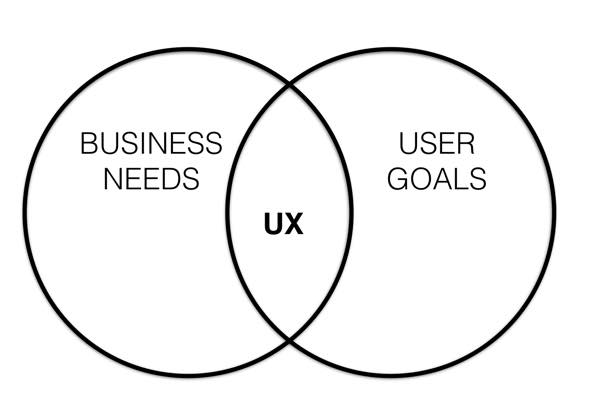The Value Loop

Joe Natoli (Give Good UX) is one of my favorite UX thought leaders. One of his most compelling concepts is called “The Value Loop”. It’s the sweet spot in the middle of the classic UX Venn diagram.
Why The Value Loop Is Important
A value loop represents the intersection between Business Needs and User Goals. With regard to digital user experience, a value loop is created when a business creates an app, site, or online transaction that benefits a target user or customer. In return, the user gives the business attention, money or both.
The user benefits from using the product, and the business benefits by making or saving money and getting valuable feedback. This creates a virtuous cycle that improves the condition of both parties. It’s a beautiful thing.
Don’t Forget The Business Side
The value loop is only possible when designers give equal time to the UX equation. Joe believes that the term “User Experience” is potentially confusing because it doesn’t include the business.
In fact, many beginning UX designers incorrectly focus only on the user. They think they must defend the user at all costs, even if it impacts the interests of the business. While we must definitely represent the user’s end goals as we design, there’s so much more to the story.
Here’s the deal. It takes two to tango:
- Without the business there is no user.
- Without the business there’s no need for interaction.
- Without the business there’s no value loop. Everybody can go home.
A Delicate Balance
As designers, we need to give proper attention to both sides of the UX diagram. For me, this is what makes UX design so challenging. When was the last time you found yourself balanced in the middle of a busy teeter totter? It ain’t easy.
To make things even more complicated, business stakeholders sometimes confuse their wants with the true needs of the business. When that happens it’s our job to help them distinguish between the two.
How do we do that? For one, we don’t skip research because we’re in a rush to get SOMETHING in front of stakeholders. That kind of shortsighted thinking does nothing to serve the business or the users. Instead we need to first understand the core design problem and who is involved. We need to dig deep instead of looking for a quick fix.
Digging Deeper
We need to ask some hard questions…like what’s driving this project? Why is it even needed? Who is it for? What does it do? What are the risks, and what’s worth doing? And then we need to talk to some real people who might actually use the thing we plan to make.
Once we get some answers we can start working on a proposed design solution built on a solid foundation. Until then it’s all spitballing. And even with a rock solid foundation, no one ever knows if a design will work as intended until it’s let loose in the wild.
That’s why the value loop is so important. It’s the true litmus test for any design effort. I try to keep that in mind whenever people and politics get dicy on a project. There’s no need to choose sides. Your design has the best chance for success when you focus on both.
What do you think? Does this make sense? Let me know in the comments.
